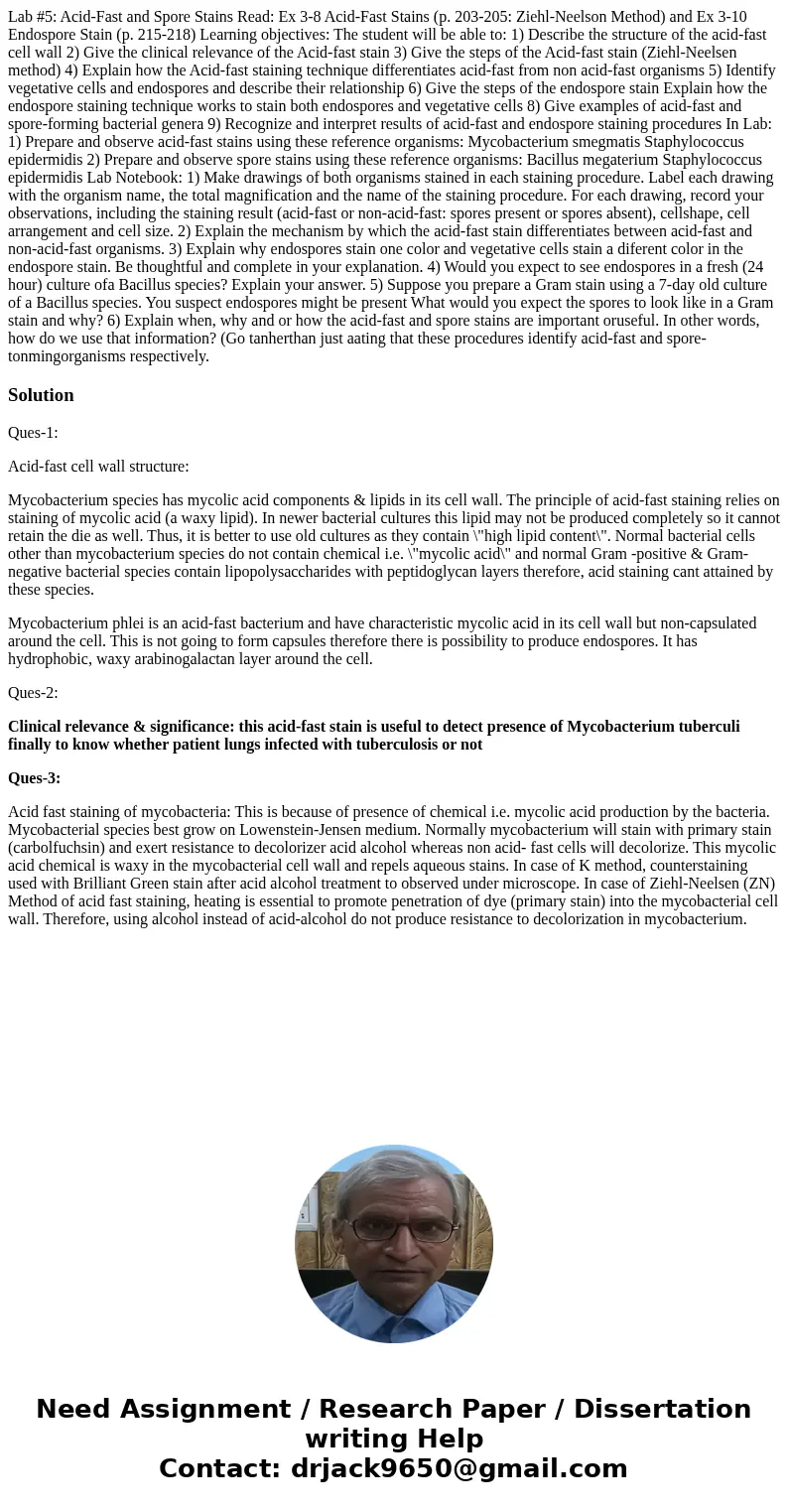Lab #5: Acid-Fast and Spore Stains Read: Ex 3-8 Acid-Fast Stains (p. 203-205: Ziehl-Neelson Method) and Ex 3-10 Endospore Stain (p. 215-218) Learning objectives: The student will be able to: 1) Describe the structure of the acid-fast cell wall 2) Give the clinical relevance of the Acid-fast stain 3) Give the steps of the Acid-fast stain (Ziehl-Neelsen method) 4) Explain how the Acid-fast staining technique differentiates acid-fast from non acid-fast organisms 5) Identify vegetative cells and endospores and describe their relationship 6) Give the steps of the endospore stain Explain how the endospore staining technique works to stain both endospores and vegetative cells 8) Give examples of acid-fast and spore-forming bacterial genera 9) Recognize and interpret results of acid-fast and endospore staining procedures In Lab: 1) Prepare and observe acid-fast stains using these reference organisms: Mycobacterium smegmatis Staphylococcus epidermidis 2) Prepare and observe spore stains using these reference organisms: Bacillus megaterium Staphylococcus epidermidis Lab Notebook: 1) Make drawings of both organisms stained in each staining procedure. Label each drawing with the organism name, the total magnification and the name of the staining procedure. For each drawing, record your observations, including the staining result (acid-fast or non-acid-fast: spores present or spores absent), cellshape, cell arrangement and cell size. 2) Explain the mechanism by which the acid-fast stain differentiates between acid-fast and non-acid-fast organisms. 3) Explain why endospores stain one color and vegetative cells stain a diferent color in the endospore stain. Be thoughtful and complete in your explanation. 4) Would you expect to see endospores in a fresh (24 hour) culture ofa Bacillus species? Explain your answer. 5) Suppose you prepare a Gram stain using a 7-day old culture of a Bacillus species. You suspect endospores might be present What would you expect the spores to look like in a Gram stain and why? 6) Explain when, why and or how the acid-fast and spore stains are important oruseful. In other words, how do we use that information? (Go tanherthan just aating that these procedures identify acid-fast and spore-tonmingorganisms respectively.
Ques-1:
Acid-fast cell wall structure:
Mycobacterium species has mycolic acid components & lipids in its cell wall. The principle of acid-fast staining relies on staining of mycolic acid (a waxy lipid). In newer bacterial cultures this lipid may not be produced completely so it cannot retain the die as well. Thus, it is better to use old cultures as they contain \"high lipid content\". Normal bacterial cells other than mycobacterium species do not contain chemical i.e. \"mycolic acid\" and normal Gram -positive & Gram- negative bacterial species contain lipopolysaccharides with peptidoglycan layers therefore, acid staining cant attained by these species.
Mycobacterium phlei is an acid-fast bacterium and have characteristic mycolic acid in its cell wall but non-capsulated around the cell. This is not going to form capsules therefore there is possibility to produce endospores. It has hydrophobic, waxy arabinogalactan layer around the cell.
Ques-2:
Clinical relevance & significance: this acid-fast stain is useful to detect presence of Mycobacterium tuberculi finally to know whether patient lungs infected with tuberculosis or not
Ques-3:
Acid fast staining of mycobacteria: This is because of presence of chemical i.e. mycolic acid production by the bacteria. Mycobacterial species best grow on Lowenstein-Jensen medium. Normally mycobacterium will stain with primary stain (carbolfuchsin) and exert resistance to decolorizer acid alcohol whereas non acid- fast cells will decolorize. This mycolic acid chemical is waxy in the mycobacterial cell wall and repels aqueous stains. In case of K method, counterstaining used with Brilliant Green stain after acid alcohol treatment to observed under microscope. In case of Ziehl-Neelsen (ZN) Method of acid fast staining, heating is essential to promote penetration of dye (primary stain) into the mycobacterial cell wall. Therefore, using alcohol instead of acid-alcohol do not produce resistance to decolorization in mycobacterium.

 Homework Sourse
Homework Sourse